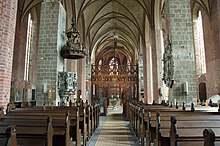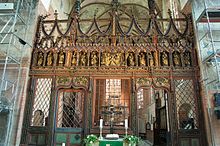St. Jacobi (Stendal)
The St. Jacobi Church in Stendal is a Protestant town church in the brick Gothic style . It belongs to the Stendal parish of the Evangelical Church in Central Germany and is located in the northern part of downtown Stendal.
History and architecture
St. Jacobi in Stendal was built in the 14th and 15th centuries as a three-nave, six-bay Gothic hall church with a three-bay, single-nave choir . The lower part is made of granite blocks, the upper part in brick. The choir closes with a slightly irregular five-sided polygon . Several construction phases can be seen. The oldest part was started in 1311 or 1340 (depending on the interpretation of the donor's inscription on the south wall) and includes the three eastern yokes of the main nave. The nave was then given the choir completed in 1347/1348 and expanded to the west in the second half of the 14th century. The construction seam is marked by two pillars made of granite blocks. The remaining pillars are brick octagonal pillars that carry stepped partition arches and the ribbed vaults. Tall three-part and four-part windows illuminate the interior. The originally Romanesque tower was taken over from the previous building. This tower collapsed in 1808 and was replaced by the current tower with a pointed helmet from 1893 to 1901. During this construction work, the interior of the church was also restored, whereby the interior color was renewed in accordance with the material, the polychromy of the pulpit was restored and a new organ with a renaissance façade was installed in place of the organ from 1583.
Furnishing
The altar has an elaborate, multi-figure sandstone retable that was made by Hans Hacke between 1600 and 1603 . The retable is structured by a three-part architecture with three floors. The Passover Supper is shown in the middle field, and below it the Last Supper. The side panels show Saints Jerome and James the Elder. In the essay, which is crowned by a Salvator figure, Christ as Redeemer and the Holy Trinity are depicted. The original painting has not been preserved.
The stone, painted pulpit from 1612 is the work of Hans Hacke, to whom the altar is also attributed. The pulpit basket is supported by a column in front of which Saint James is depicted, the relief fields of the basket and the staircase parapet are decorated with scenes from the Old and New Testaments. The sound cover was made in 1902 using old figures. The font was made from sandstone around 1560.
The choir is separated by a late Gothic wooden choir screen with iron bars, similar to the one in St. Marien in Stendal. Two portals with keel arches lead into the choir, above which 13 figure niches are arranged, which are crowned with canopies. The choir screen is closed at the top by an ornamental split made of crossed keel arches with plant-like curved finials , in which a triumphal cross group is attached.
In the choir there are six windows with medieval stained glass from the 14th and 15th centuries. Remarkable as preserved medieval furniture is a seat from 1420/30, the cheeks of which are decorated with a Madonna and scenes from the Old Testament. A Gothic sacraments niche in the choir and wall paintings from the early 16th century complete the rich medieval furnishings.
The organ is a work of the Stendal workshop Voigt with 28 stops on two manuals and a pedal, which was built between 1898 and 1902.
Finally, several epitaphs and tombs should be mentioned. This includes the elaborate sandstone epitaph for Pastor Daniel Mahs († 1618) on the central pillar of the south arcades and the double epitaph for Johann Lüderitz († 1615) and his wife († 1598) on the north wall. The entire choir floor is made of grave slabs; including numerous valuable inscription tombstones from the 18th century.
literature
- Georg Dehio : Handbook of the German art monuments. Saxony Anhalt I. District of Magdeburg. Deutscher Kunstverlag, Munich / Berlin 2002, ISBN 3-422-03069-7 , pp. 888–892.
- Walter May: City churches in Saxony / Anhalt. 1st edition. Evangelical Publishing House, Berlin 1979.
- Thomas Hartwig: All Altmarkkirchen from A to Z. Elbe-Havel-Verlag, Havelberg 2012. ISBN 978-3-981-4039-5-4 , p. 467.
Web links
Individual evidence
- ^ Peter Findeisen: History of the preservation of monuments in Saxony-Anhalt. From the beginning to the first third of the 20th century. Verlag für Bauwesen, Berlin 1990, ISBN 3-345-00465-8 , pp. 241–246.
Coordinates: 52 ° 36 ′ 30 ″ N , 11 ° 51 ′ 28 ″ E




